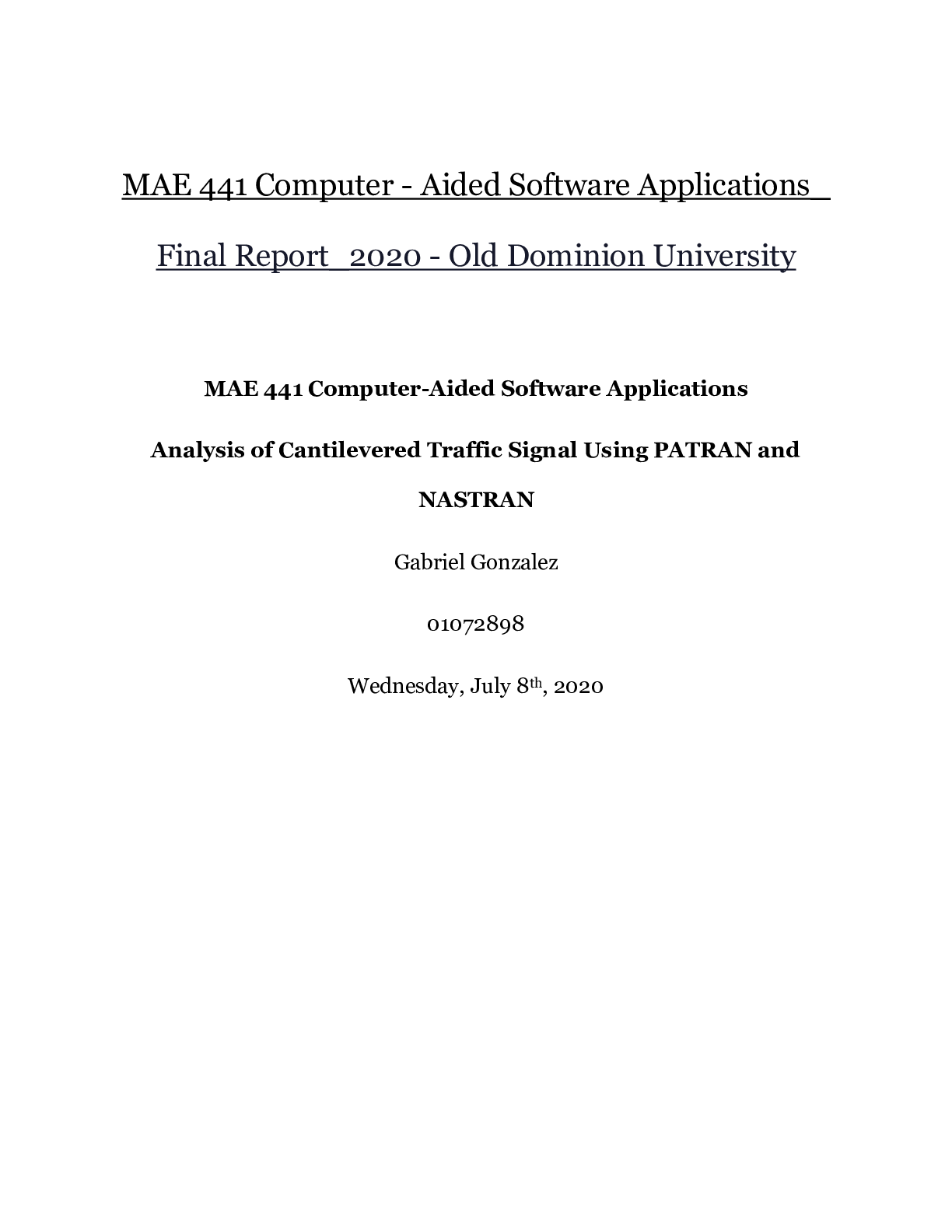Computer Science > Report > MAE 441 Computer - Aided Software Applications_ Final Report_2020 - Old Dominion University | Analys (All)
MAE 441 Computer - Aided Software Applications_ Final Report_2020 - Old Dominion University | Analysis of Cantilevered Traffic Signal Using PATRAN and NASTRAN
Document Content and Description Below
MAE 441 Computer - Aided Software Applications_ Final Report_2020 - Old Dominion University MAE 441 Computer-Aided Software Applications Analysis of Cantilevered Traffic Signal Using PATRAN and NA... STRAN Gabriel Gonzalez 01072898 Wednesday, July 8th, 2020 Abstract Traffic signals rely on a sturdy base to ensure they can withstand the forces of wind, traffic gusts, and the weight of their traffic signs. To stay upright, their base consists of a base plate, four anchor bolts, and welds between the traffic pole and base plate. These components are made from AISI No 1010 CD steel. The addition of slots within the base plates was the topic of investigation in this report. By adding slots, it was theorized that the base plate and anchor bolts would experience less stress from the forces applied to the pole. However, this addition would increase manufacturing costs of the base plate. By using PATRAN and NASTRAN, a thorough evaluation of two base plates, one with and without slots, was conducted. It was concluded that adding slots did not yield any advantage to the base plate without slots. The base plot with slots put less axial stress on the anchor bolts, but the difference was not big enough to warrant the more expensive manufacturing cost. Additionally, the displacement of the pole, and overall stress levels of the base plate were higher on the base plate with slots. Overall, the base plate with no slots proved beneficial over the base plate with slots through its stress and displacement analysis in PATRAN and NASTRAN Introduction The construction of traffic signals is important for promoting the safety of motor vehicle users on public roads. Cantilevered traffic signals are constructed with the use of poles, signals, base plates and anchor bolts. The signals are attached to a cantilevered pole, while the cantilevered pole is attached to a pole normal to the ground. The pole normal to the ground is secured to a base plate, which is then connected to a foundation using anchor bolts. To ensure the traffic signal operates safely, the cantilevered pole must not fall. The main component that prevents the cantilevered pole from falling is the base plate and the anchor bolts. The base plate and anchor bolts hold the main pole of the traffic signal upright. The cantilevered pole then applies force to the upright pole, which then apply force to the base plate and anchor bolts. If the base plate or anchor bolts are unable to withstand the force applied by the cantilevered beam, the traffic signal will fail and be unable to operate. Therefore, the purpose of this study is to analyze the forces applied to the foundation of a cantilevered traffic signal using NASTRAN and PATRAN to predict whether a traffic signal will fail. This analysis would aid in the construction of safe traffic signals. Additionally, it will help provide insight on methods that can be used to prevent failure of cantilevered traffic signals due to weak components or overly heavy loads. Background Cantilevered beams experience three main loads: downward loads, moment loads and torsion. Downward loads and moment loads can be produced by the weight of the cantilevered beam, weight of the objects attached to the beam, or forces such as wind. Torsion can be produced by objects placing forces on the beam that cause a moment around the local axis of the beam. For this analysis, the forces are assumed to be the same for both types of base plate. There will be a downward force, horizontal force, moment and torsional force. Below are the equations used to find forces within a cantilever beam: (1) (2) (3) (4) (5) The expected outcome of this analysis is a detailed PATRAN file that will read the stresses and forces applied on a base plate and anchor bolts with a given load on a cantilevered pole. It is also predicted that the base plate and anchor bolts will be sufficient in holding the load and that there will be room for improving the cantilevered traffic signal to reduce stress placed on base plates and anchor bolts. Sketch of Geometry Model The sketches above show the main components that will be addressed in this analysis. To create a geometry model of this traffic signal, the upright pole will be created first. The upright pole is a hollow circular beam with an outer radius of 4 inches and thickness of .12 inches. To create this, a curve will be created that will start from the top of the base plate and go the full length of the dimension “A”. A will have a value of 240 inches. The curve will then be meshed, and a beam property will be applied that reflects the beam’s properties. The upright pole will be welded onto the base plate. To simulate a weld between the pole and the base plate, an MPC RBE2 will be used. The first point of the pole’s curve will be an independent node, and a circle of nodes on the base plate will be the dependent nodes. The circle of dependent nodes will have a radius of 4 inches. The base plate being analyzed in this study has a length and width of 8.75 inches, and a height of 0.75 inches. Additionally, the anchor bolts being analyzed have a nominal diameter of 0.75 inches and are used in conjunction with a washer. The base plate will be made through simple editing, meshing and creation of points, curves and surfaces. The shell of the base plate will reflect the dimensions of the sketch. The anchor bolts will be represented by circular beams created using curves, meshes and beam -- -- - - - - - - - - - - - - - - - -- - - - - - - - -- - - Comparing the displacement analysis of the pole on the base with slots and the pole on the base with no slots, their maximal displacement values were very similar. The pole with slots experienced a displacement of 2.05E+01 inches, while the pole with no slots experienced a displacement of 2.03E+01 inches. The vector form of displacement of the pole with slots was <-1.16E+01, -1.67E+01, -7.32E-04> inches. The vector form of the pole without slots was <-1.16E+01, -1.67E+01, -7.34E-04> inches. The MPC constraint forces of the base plate with slots reached a maximum value of 8.19+E3 psi, while the base plate with no slots reached a maximum value of 8.20E+03 psi. The maximum value of stress von mises reached on the base plate with slots was 3.30E+04 psi. The maximum stress von mises value reached on the base plate with no slots was 3.28E+04 psi. The maximum axial stress experienced by an anchor bolt was 1.58E+04 psi on the base plate with slots. On the base plate with no slots, the maximum axial stress experienced 1.57E+04 psi. [Show More]
Last updated: 1 year ago
Preview 1 out of 21 pages

Buy this document to get the full access instantly
Instant Download Access after purchase
Add to cartInstant download
We Accept:

Reviews( 0 )
$12.50
Document information
Connected school, study & course
About the document
Uploaded On
Nov 12, 2020
Number of pages
21
Written in
Additional information
This document has been written for:
Uploaded
Nov 12, 2020
Downloads
0
Views
81



 – Chamberlain College of Nursing.png)

